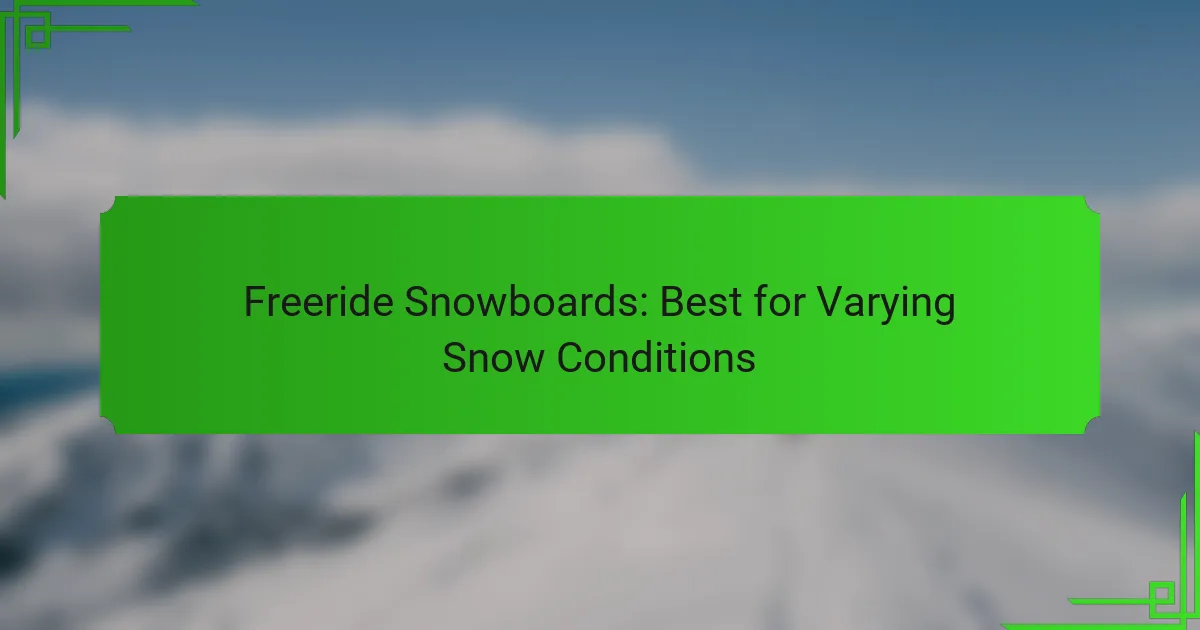Freeride snowboards designed for varying snow conditions offer a versatile experience, adapting seamlessly to diverse terrains and snow types. Key features such as shape, flex, and construction materials play a crucial role in optimizing performance across powder, groomed runs, and mixed conditions. By understanding these elements, riders can enhance their experience and select the ideal board for their needs.

Which Freeride Snowboards Perform Best in Varying Snow Conditions?
Freeride snowboards that excel in varying snow conditions typically feature a versatile design, allowing for adaptability across different terrains and snow types. Key factors include the board’s shape, flex, and construction materials, which influence performance in powder, groomed runs, and mixed conditions.
Burton Custom X
The Burton Custom X is known for its aggressive performance and responsiveness, making it a top choice for advanced riders tackling diverse snow conditions. Its directional shape and stiffer flex provide stability at high speeds, while the lightweight construction enhances maneuverability in powder.
This board features a camber profile that excels on hardpack and groomed runs, allowing for precise turns and edge control. Riders should consider its suitability for their skill level, as it is best suited for those with experience in freeriding.
Lib Tech T.Rice Pro
The Lib Tech T.Rice Pro is designed for versatility, combining a hybrid rocker-camber profile that performs well in both powder and on groomed trails. This snowboard offers a balanced flex that allows for easy turns while maintaining stability in variable conditions.
Its eco-friendly construction and unique Magne-Traction edges provide enhanced grip on icy surfaces, making it a reliable option for unpredictable weather. Riders looking for a board that can handle everything from deep powder to hardpack will find this model appealing.
Jones Flagship
The Jones Flagship is built for serious freeriders who demand performance in challenging conditions. Its directional shape and stiff flex make it ideal for aggressive riding in deep snow, while the rocker profile helps with floatation in powder.
This board is equipped with a sustainable construction that enhances durability and responsiveness. Riders should be aware that its stiffness may require a more advanced skill set to fully utilize its capabilities, especially in variable terrain.
Salomon Assassin
The Salomon Assassin is a versatile snowboard that balances performance across various snow conditions. Its twin directional shape and medium flex make it suitable for both freestyle and freeride applications, allowing riders to adapt to changing environments.
This board features a mix of rocker and camber profiles, providing a smooth ride in powder while maintaining edge control on hardpack. It’s a great option for intermediate to advanced riders looking for a do-it-all snowboard.
Ride Warpig
The Ride Warpig is a unique board designed for versatility in all snow conditions, featuring a short and wide shape that enhances floatation in powder while remaining agile on groomed runs. Its playful flex allows for easy maneuvering and tricks, making it a fun choice for riders who enjoy a mix of styles.
This board’s design encourages a more centered stance, which helps with balance and control in varied terrain. Riders should consider its suitability for their riding style, as it excels in playful, freestyle-oriented freeriding.

What Features Should You Look for in a Freeride Snowboard?
When selecting a freeride snowboard, prioritize features that enhance performance in diverse snow conditions. Key aspects include flexibility, edge control, shape and design, and weight, all of which contribute to a board’s ability to handle varying terrains and snow types.
Flexibility
Flexibility in a freeride snowboard affects how well it responds to different snow conditions. A stiffer board offers better stability and control at high speeds, making it ideal for hard-packed snow. Conversely, a more flexible board allows for easier maneuverability in powder and softer snow.
Consider your riding style when choosing flexibility. If you prefer aggressive carving and speed, opt for a stiffer board. For those who enjoy playful riding in powder, a softer flex is more suitable.
Edge Control
Edge control is crucial for maintaining grip and stability on various surfaces. Look for boards with sharp, well-defined edges that can dig into hard snow and ice, providing better traction. A board with a sidecut radius that matches your riding style can enhance your ability to carve effectively.
For optimal edge control, consider boards with features like magnetraction or serrated edges, which improve grip on icy slopes. This is particularly beneficial in regions with variable snow conditions.
Shape and Design
The shape and design of a freeride snowboard significantly influence its performance. Directional shapes are common, as they are designed to excel in one direction, providing better float in powder and stability on descents. Some boards feature a tapered design, which helps with maneuverability in deep snow.
Evaluate the rocker and camber profiles as well. A board with a rocker profile offers better floatation in powder, while a camber profile provides enhanced edge hold and responsiveness on groomed runs.
Weight
The weight of a freeride snowboard affects how easily it can be maneuvered and transported. Lighter boards are generally easier to handle, especially in backcountry settings where hiking is involved. However, a heavier board can provide more stability and durability on rough terrain.
When selecting weight, balance is key. Look for boards that use lightweight materials without sacrificing strength. This will help you maintain control while reducing fatigue during long rides.

How Do Different Snow Conditions Affect Freeride Snowboard Performance?
Different snow conditions significantly impact the performance of freeride snowboards, influencing factors such as maneuverability, speed, and stability. Understanding how your board interacts with powder, hardpack, and slush can enhance your riding experience and help you choose the right equipment.
Powder Performance
Freeride snowboards excel in powder due to their wider noses and tapered tails, which help float on soft snow. A board with a rockered profile is particularly beneficial, as it allows for easier turns and better maneuverability in deep snow.
When riding in powder, consider the board’s length; longer boards generally provide better floatation. However, they may sacrifice some agility, so choose a length that balances both aspects based on your riding style and preferences.
Hardpack Performance
On hardpack, freeride snowboards need to offer stability and edge control. Boards with a stiffer flex and camber profile can provide the necessary grip on icy surfaces, allowing for precise turns and control at higher speeds.
To optimize performance on hardpack, ensure your edges are well-tuned. Dull edges can lead to slipping, while sharp edges enhance grip. Regular maintenance is key to maintaining optimal performance in these conditions.
Slush Performance
Slush conditions require a balance between floatation and control. Freeride boards with a softer flex can absorb the unevenness of slushy terrain, making for a more comfortable ride. A board with a slightly wider waist can also help prevent sinking.
When navigating slush, avoid overly aggressive turns, as they can cause the board to dig in and lose speed. Instead, focus on smooth, flowing movements to maintain momentum and enjoy the softer snow without getting bogged down.

What Are the Best Freeride Snowboard Brands for All Conditions?
The best freeride snowboard brands for varying snow conditions include Burton, Lib Tech, Jones, and Salomon. These brands are known for their innovative designs and technology that enhance performance across different terrains and snow types.
Burton
Burton is a leading name in the snowboarding industry, renowned for its high-quality freeride boards. Their models often feature advanced materials and designs that provide excellent stability and control in powder and variable conditions.
When selecting a Burton snowboard, consider the Flex rating and the board’s shape. A stiffer board may offer better performance in deep snow, while a more flexible board can enhance maneuverability on groomed runs.
Lib Tech
Lib Tech is celebrated for its environmentally friendly manufacturing processes and innovative technologies. Their boards often include features like Magne-Traction edges, which improve grip on icy surfaces, making them suitable for diverse conditions.
Look for Lib Tech boards with a hybrid camber profile for versatility. This design allows for better float in powder while maintaining edge control on hardpack snow.
Jones
Jones Snowboards focuses on backcountry and freeride performance, making them a top choice for adventurous riders. Their boards are designed to excel in deep snow and rugged terrain, often incorporating features like directional shapes and rocker profiles.
For optimal performance, consider Jones boards with a stiffer flex for stability at high speeds and in challenging conditions. Their boards are also equipped with sustainable materials, appealing to eco-conscious riders.
Salomon
Salomon offers a range of freeride snowboards that balance performance and accessibility. Their boards are known for being lightweight yet durable, making them ideal for various snow conditions.
When choosing a Salomon snowboard, pay attention to the board’s width and length to match your riding style and snow conditions. A wider board can provide better float in powder, while a shorter board may enhance agility in tight spaces.

How to Choose the Right Freeride Snowboard for Your Style?
Choosing the right freeride snowboard involves understanding your unique riding style and skill level. This ensures that you select a board that enhances your performance in varying snow conditions, providing the best experience on the slopes.
Assessing Riding Style
Your riding style significantly influences the type of freeride snowboard you should choose. Consider whether you prefer aggressive turns, powder riding, or a mix of both. Boards designed for aggressive riders often feature a stiffer flex and a directional shape, while those aimed at powder enthusiasts may have a wider nose and a tapered tail.
To assess your style, think about the terrain you enjoy most. If you frequently ride in backcountry areas or deep snow, look for boards with a larger surface area to help with floatation. Conversely, if you enjoy groomed runs and tight turns, a more responsive board with a narrower profile will suit you better.
Considering Skill Level
Your skill level plays a crucial role in selecting a freeride snowboard. Beginners typically benefit from softer, more forgiving boards that allow for easier maneuverability and control. As you progress, a stiffer board can provide better stability at higher speeds and improved performance in challenging conditions.
When evaluating your skill level, consider how comfortable you are with various techniques, such as carving and jumping. Intermediate riders might look for boards that offer a balance between stability and flexibility, while advanced riders should prioritize precision and responsiveness. Always test different boards if possible to find the best fit for your abilities.
